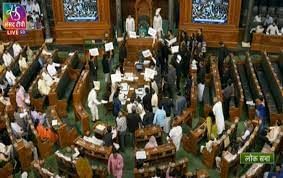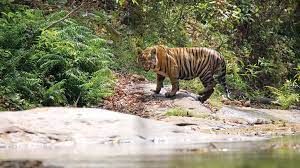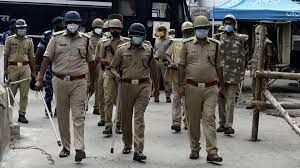UPSC Daily Current Affairs- 6th April 2023 | Current Affairs & Hindu Analysis: Daily, Weekly & Monthly PDF Download
GS-I
Subansiri dam project

Why in News?
Recently, the contentious Subansiri Lower Dam project was hit by a landslide during pre-monsoon rain in the region.
About the Subansiri Dam project:
- It is the biggest hydroelectric project undertaken in India so far.
- It is a run-of-river scheme on river Subansiri.
- Location: The Project is located near North Lakhimpur on the border of Arunachal Pradesh and Assam.
- Capacity:2000MW
- It is a concrete gravity dam 116 m high from river bed level.
- It is being developed by the state-run National Hydro Power Corporation (NHPC).
Key facts about the Subansiri River
- It originates in the Tibet Plateau and is the largest tributary of the Brahmaputra River.
- The high topographic variation makes this river a potential zone for harnessing it for the hydropower
What is a Gravity dam?
- Gravity dams are massive structure dams which are constructed of concrete or stone masonry.
- This type of structure is durable and requires very little maintenance.
Source: Indian Express
GS-II
The Need For Humane Policing In India
Why in News?
The recent case of human rights violation against an IPS officer in Ambasamudram highlights the need for humane policing in India. The history of police brutality across the globe, including in the US, reveals the need for change in the policing system. The pressure to produce results, coupled with corruption and lack of ethics training, contributes to police excesses, which must be curbed.
History of Policing Excesses
- Policing Excesses in U.S: The history of policing in many countries is pockmarked by episodes of excesses, and the U.S. is one such country which has had far too many instances of police torture.
- For example: The Rodney King incident of 1991 in Los Angeles and the death of George Floyd in Minneapolis in 2020 are some examples of police brutality.
Factors Contributing to Police Excesses in India
- Corruption among public servants: Corruption is rampant in India and is a major factor contributing to police excesses. Bribery and corruption make it easy for criminals to escape the law and for police officers to use violence and coercion to extract money and other benefits.
- The pressure to produce results: Police officers are often under tremendous pressure to produce results and show that they are making progress in solving cases. This pressure can lead to an overzealous approach to policing, with officers resorting to torture and other illegal methods to extract information and solve cases quickly.
- Lack of ethics training: Police officers in India are not given sufficient training in ethics and human rights. This lack of training makes it easier for officers to resort to violence and abuse of power, as they do not understand the consequences of their actions.
- Political interference: In some cases, politicians and other powerful people may interfere in police investigations or use their influence to protect criminals. This interference can undermine the rule of law and make it more difficult for police officers to do their job effectively and without fear or favor.
- Poor working conditions: Police officers in India often work long hours in difficult and dangerous conditions. This can lead to stress and fatigue, which can in turn lead to a higher incidence of police excesses.
- Lack of accountability: There is often little accountability for police officers who commit excesses. In many cases, officers who are found guilty of human rights violations are simply transferred to another location, rather than being punished or dismissed from the force. This lack of accountability sends a message to other officers that they can get away with abuse of power and violence.
Role of Technology and Ethics in Policing
- Both technology and ethics are necessary for effective policing: While technology can help solve crimes and improve policing efficiency, ethics and a commitment to human rights are necessary to ensure that police officers act within the law and respect the rights of all citizens.
- Technology alone is not enough: The technology has played a significant role in improving policing in India, with many officers now trained in the use of modern tools and techniques to solve crimes. However, technology alone is not enough, and that ethics must also be prioritized in policing.
- Training in ethics must be prioritized at all levels of the police force: Many police officers in India lack sufficient training in ethics and human rights, which makes it easier for them to resort to violence and abuse of power. Training in ethics must be prioritized at all levels of the police force, from the highest-ranking officers to those on the front lines.
- Police leaders are crucial players: The police leaders, such as DGPs and IGPs, have a crucial role to play in indoctrinating young recruits on the value of sticking to the law and civilised behaviour.
What is mean by humane policing?
- Humane policing refers to a style of law enforcement that places a greater emphasis on preserving the human rights and dignity of individuals.
- Humane policing recognizes that police officers are entrusted with great power and authority and that they have a duty to exercise this power with respect, compassion, and professionalism.
- It prioritizes building trust and positive relationships between law enforcement agencies and the communities they serve.
- Humane policing It seeks to avoid the use of excessive force, unnecessary aggression, or intimidation in policing activities.
- It recognizes the importance of accountability and transparency in law enforcement.
- It also recognizes the importance of training and education for police officers in areas such as cultural competence, mental health awareness, and conflict resolution.
Conclusion
- It is sad and equally true that many in the political firmament subscribe to the philosophy that without physical force on misbehaving citizens, the quality of policing cannot improve and law and order cannot be maintained. This perception has to be changed. India needs a human policing. Moreover, the authorities must take swift action against offending officials to send a strong message that no illegal physical treatment of crime suspects will be tolerated.
Source: The Hindu
International Water Action Conference and Voluntary Commitments

Why in News?
Recently, the United Nations 2023 Water Conference was held in New York.
About
- The Conference was held after a gap of 46 years. It coincided with the review of Implementation of the UN Decade for Action on Water and Sanitation (2018-2028).
- The review was necessitated after realisation that we are not on track to meet the 2030 Sustainable Development Goal (SDG) no. 6 for water: “Ensure availability and sustainable management of water and sanitation for all”.
- The theme was “Our watershed moment: uniting the world for water”
- The first water conference was held in 1977 in Mar de Plata, Argentina. It resulted in the first global ‘Action Plan’ recognizing that “all peoples have the right to have access to drinking water in quantities and of a quality equal to their basic needs”.
Initiatives taken at the Conference:
- Water Action Agenda : 700 voluntary commitments to form the Water Action Agenda.
- Climate resilient water and sanitation infrastructure - USA announced a commitment of up to $49 billion in investments to support climate resilient water and sanitation infrastructure and services
- Quality Infrastructure - Japan announced that it will contribute 500 billion yen to the solution of water-related social issues faced by the Asia-Pacific region by developing quality Infrastructure
- River basins management and clean running water –Vietnam pledged to develop policies for major river basins management by 2025 and clean running water by 2030
- Africa’s water investments gap - The African Union Commission and Continental Africa Investment Programme (AIP) aims to close Africa’s water investments gap by mobilising at least $30 billion per year by 2030.
- European Union (EU) - The EU aims to support 70 million individuals to an improved drinking water source and sanitation facility by 2030.
- Water Convention and transboundary cooperation – Switzerland submitted 5 commitments in the areas of Water Convention and transboundary cooperation.
Challenges :
- The commitments are non binding in nature and unlike 50 years ago, today’s problems are more complex.
- The water sector is particularly prone to fragmentation because water problems and their solutions tend to be local. Such global mobilisations are not that effective as compared to those in other fields.
- The water problems we face today are no longer about access and therefore infrastructure spending no longer translates directly to sustained access to water and sanitation.
- The conference failed to address the violence and threats faced by communities trying to protect dwindling water sources.
Source: Indian Express
GS-III
Coastal Aquaculture Authority (Amendment) Bill, 2023

Why in News?
The Coastal Aquaculture Authority (Amendment) Bill 2023 was introduced in the Lok Sabha.
What is Aquaculture?
- Aquaculture essentially means, breeding, raising, and harvesting fish, shellfish, and aquatic plants.
- In a nutshell, it’s farming in water.
- Saline water along the coast has been found to be suitable for practising aquaculture which produces shrimp, majorly.
- If aquaculture is not practised on this land, it will be left idle and uncultivated as it is not suitable for the cultivation of crops.
- Aquaculture can be practised on about 12 lakh hectares in the country along the coast, of which only 14% has been utilized so far.
Key highlights of the amendment
- Decriminalisation of certain offences: The Bill aims to decriminalize the offences under the Coastal Aquaculture Authority Act.
- Fine-tuning operational procedures: It seeks to promote ease of doing business and to fine-tune the operational procedures of the authority.
- Promotion of environment-friendly coastal aquaculture: The Bill also aims to promote newer forms of environment-friendly coastal aquaculture, such as cage culture, seaweed culture, marine ornamental fish culture, and pearl oyster culture.
- Create employment opportunities: These newer forms of coastal aquaculture have the potential to create additional employment opportunities.
- Prevention of use of harmful substances in coastal aquaculture: The Bill also includes a provision to prevent the use of antibiotics and pharmacologically active substances that are harmful to human health in coastal aquaculture.
About the Coastal Aquaculture Act
- This Act was enacted in the year 2005 for the establishment an authority to regulate activities in this sector.
- It is a parliamentary act that establishes the Coastal Aquaculture Authority (CAA) for the regulation and registration of coastal aquaculture farms in India.
Overview
- The CAA Act, of 2005 mandates the Central Government to take measures to regulate coastal aquaculture and ensure that it does not cause any harm to the coastal environment.
- The guidelines prescribed by the government aim to promote responsible coastal aquaculture practices that protect the livelihood of various coastal communities.
Key features
- The CAA Act, 2005 provides for the establishment of the Coastal Aquaculture Authority to regulate the activities related to coastal aquaculture.
- The Central Government is responsible for prescribing guidelines to regulate coastal aquaculture activities and ensure responsible practices.
- The guidelines aim to protect the livelihood of coastal communities and prevent any harm to the coastal environment.
- The Act also mandates the registration of coastal aquaculture farms to ensure their compliance with the guidelines.
- The CAA is a strong force in enforcing the regulations and registration of coastal aquaculture farms in India.
Significance
- The Coastal Aquaculture Authority Act, of 2005 is significant in promoting responsible coastal aquaculture practices and protecting the livelihood of coastal communities.
- The act ensures that coastal aquaculture activities are regulated and registered, which helps prevent harm to the coastal environment.
Source: The Hindu
Slocum gliders

Why in News?
Recently, the Indian National Centre for Ocean Information Services (INCOIS), under the Ministry of Earth Sciences (MoES), has just launched two fresh modern deep seas ‘Slocum’ gliders in the Bay of Bengal.
About Slocum gliders:
- Slocum gliders are a type of autonomous underwater vehicle (AUV) that are capable of carrying out long-duration missions, spanning several months or even years, to collect scientific data from the ocean.
- Objective: To study the physical and biogeochemical parameters of the sea and get an insight into climate change.
- Features of the gliders
- The state-of-the-art gliders are equipped with sensors to track temperature, salinity, chlorophyll, dissolved oxygen, and PAR – photosynthetic active radiation in the seawater among others.
- The gliders have been deployed from the Ocean Research Vehicle ‘Sagar Manjusha’ of the National Institute of Ocean Technology (NIOT) off the Chennai coast outside of the EEZ - exclusive economic zone boundary
- These gliders can go underwater up to a depth of about 1,000 metres and will surface four to five times a day.
- These gliders which run on the lithium-ion battery is they come with an extended battery life of nine months and more to cover both the north and south transect of the Bay of the Bengal.
- They can travel up to 15 km a day.
- The project comes under the ‘Deep Ocean Mission of the Ministry of Earth Science
What is INCOIS?
- It was established as an autonomous body in 1999 under the Ministry of Earth Sciences (MoES).
- Mandate: To provide the best possible ocean information and advisory services to society, industry, government agencies and the scientific community through sustained ocean observations and constant improvements through systematic and focused research.
Source: The Hindu
What is the Open-Source Seeds Movement?
Why in News?
The article discusses the concept of open-source software and its parallels with open-source seeds.
- Richard Stallman pioneered the Free Software Movement and developed the General Public License (GPL) to protect users’ rights and prevent code misappropriation.
- Farmers have been innovating and sharing seeds without intellectual property rights (IPR) claims for centuries.
Backgrounder: Plant Breeders’ Rights
- Plant breeders’ rights (PBR) granted exclusive rights to breeders and developers of new varieties.
- Farmers’ rights were limited under this regime.
- The TRIPS agreement established a global IPR regime over plant varieties.
- The consolidation of the seed sector raised concerns about the freedom to innovate.
Forms of IPR Protection in Agriculture
- There are now two forms of IPR protection in agriculture: PBR and patents.
- Together, they restrict farmers’ rights and the freedom to develop new varieties.
- The use of genetically modified seeds and IP claims triggered many problems, including State intervention on Bt cotton seeds in India.
- The decline of public sector breeding and the dominance of the private sector in the seed sector increased the need for alternatives.
What are Open Source Seeds?
- The success of open-source software inspired a solution for seeds.
- In 1999, a Canadian plant breeder named T.E. Michaels suggested an approach to seeds based on the principles of open-source software.
- In 2012, Jack Kloppenburg launched the Open Source Seeds Initiative (OSSI) in Wisconsin.
- Agrecol launched another initiative in Europe, and similar programs have come up worldwide.
Open Source Seeds Initiatives in India
- In India, the Hyderabad-based Centre for Sustainable Agriculture (CSA), part of the Apna Beej Network, developed a model incorporated into an agreement between CSA and the recipient of the seed/germplasm.
- CSA’s Open Source Seeds Initiative uses a contracts approach similar to Agrecol’s strategy.
- The number of seed firms using open-source models and the crop varieties and seeds made available thereunder is small but growing.
- India is yet to test and adopt it widely.
Potential Applications of Open-Source Seeds
- Open-source principles can help promote farmer-led participatory plant-breeding exercises.
- Traditional varieties often lack uniformity and aren’t of excellent quality, but open-source principles can facilitate testing, improvisation, and adoption.
- Open-source principles can be used in farmer-led seed conservation and distribution systems.
- The government and other stakeholders can consider adopting this approach to more widely adopt traditional varieties.
Source: The Hindu
Parambikulam Tiger Reserve

Why in News?
Recently, a Division Bench of the Kerala High Court ordered that the wild elephant Arikompan roaming at Santhanpara and Chinnakkanal in Idukki district be captured, radio-collared, and translocated to the Parambikulam Tiger Reserve.
About Parambikulam Tiger Reserve:
- It is one of the premier Tiger Reserves of India and is endowed by nature in terms of species, habitat and ecosystem diversity.
- It is located in the Palakkad District of Kerala and lies in between the Anamalai Hills and Nelliampathy Hills of the Southern Western Ghats.
- Flora: It supports diverse habitat types namely; evergreen forests, moist and dry deciduous forests and grasslands.
- Fauna: Lion-tailed macaques, Malabar giant squirrel and Flying squirrel, Tarantula (large-bodied spiders) etc.
- There are several endemic, rare, endangered and threatened (RET) species of flora and fauna adding to the diversity of the Reserve. To name a few,
- Coscinium fenestratum and Utleria salicifolia (the IUCN ‘red listed’ medicinal plants endemic to Anamalais)
- Tomopterna parambikulamana (an endemic frog of Parambikulam)
- Garra surendranathanii (an endemic sucker fish)
Source: The Hindu
|
63 videos|5408 docs|1146 tests
|
FAQs on UPSC Daily Current Affairs- 6th April 2023 - Current Affairs & Hindu Analysis: Daily, Weekly & Monthly
| 1. What is the significance of GS-I, GS-II, and GS-III in the UPSC exam? |  |
| 2. How can I prepare for GS-I in the UPSC exam? |  |
| 3. What are the important areas to focus on for GS-II in the UPSC exam? |  |
| 4. How can I prepare for GS-III in the UPSC exam? |  |
| 5. Are there any specific resources or books recommended for preparing for the GS papers in the UPSC exam? |  |


















